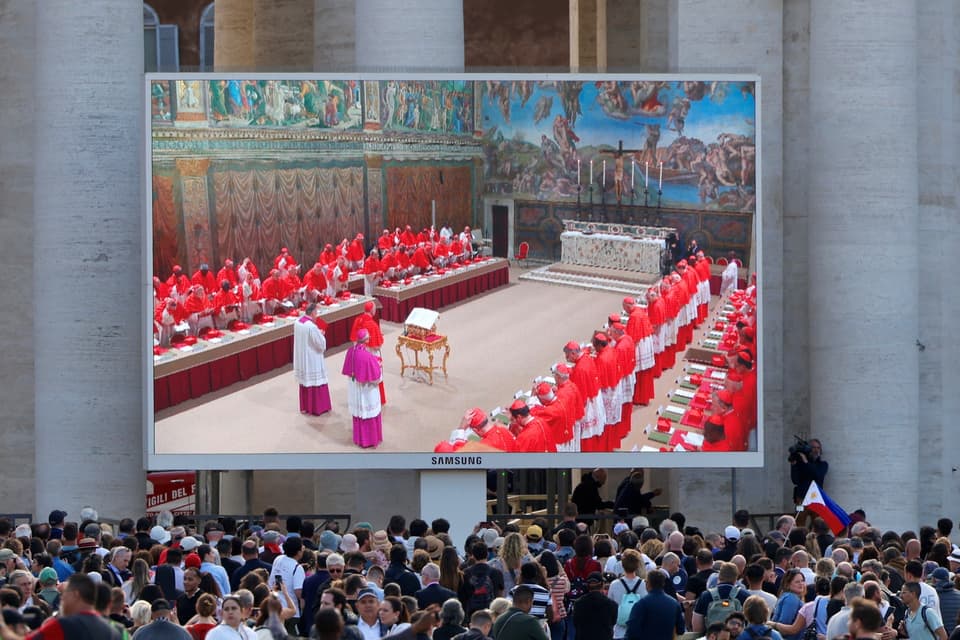Cardinals will vote again on Thursday to choose the new pope after black smoke rose from the Sistine Chapel following the first secret vote as the conclave began.
The smoke billowed out at 9 pm.Wednesday, some four hours after 133 cardinals solemnly entered the Chapel, took their oaths of secrecy and formally opened the centuries-old ritual to elect a successor to Pope Francis to lead the 1.4 billion-member Catholic Church.
With no one securing the necessary two-thirds majority, or 89 votes, the cardinals will retire for the night to the Vatican residences where they are being sequestered.
Voting will resume on Thursday, with up to four rounds of voting now able to take place each day, two in the morning and two in the afternoon.

Cardinals, mostly dressed in distinctive bright red vestments, heard at a special mass on Wednesday of the “choice of exceptional importance” they must make in electing the 267th pope.
A new pope requires a two-thirds majority in the voting, and white smoke will be emitted from the specially erected chimney of the Sistine Chapel to confirm a pontiff has been chosen.
There are three UK cardinals taking part in the conclave, Cardinal Vincent Nichols, Cardinal Timothy Radcliffe and Rome-based Cardinal Arthur Roche.

Cardinal Kevin Farrell, who is Irish-born, is seen as an American cardinal having ministered mainly in the US.
Cardinal Nichols had called on people to pray for himself and other cardinals as they embark on the secret voting process, adding that he feels “quite intimidated” knowing the world is watching to see who they choose.
The voting cardinals, those aged under 80 who are the only ones eligible to cast a ballot, were urged to “invoke the help of the Holy Spirit” to help them elect a pope “whom the (Catholic) Church and humanity need at this difficult and complex turning point in history”.
Addressing them in St Peter’s Basilica, Cardinal Giovanni Battista Re said: “To pray, by invoking the Holy Spirit, is the only right and proper attitude to take as the cardinal electors prepare to undertake an act of the highest human and ecclesial responsibility and to make a choice of exceptional importance.
Read More
The pontiff – believed to be someone called to be the successor to St Peter, who was the first pope – will need to be a person who can “awaken the consciences of all and the moral and spiritual energies in today’s society, characterised by great technological progress but which tends to forget God”, Cardinal Battista Re added.

Following a centuries-old tradition, cardinals are cut off from all communications with the outside world while they take part in the anonymous voting process.
In a livestream from the Sistine Chapel, the electors could each be seen taking an oath pledging secrecy on their vote and what happens at conclave.
The livestream cut to crowds in St Peter’s Square in front of St Peter’s Basilica, some of whom waved when they spotted they were on camera.

Pope Francis had appointed some 108 of the 133 cardinals who will choose his successor.
The next pope must be someone who can bring together disparate groups within the Catholic Church, an emeritus professor of Catholic theology at the University of Bristol said.
“The priority will be to select a pope who embodies the common good, who can unite disparate groups within Catholics, and provide a vision of the Church that can be conducive to peace, co-operation and justice in a broken world.”

Francis was vocal on politics, speaking out against war and climate change, as he urged more focus on the poor and downtrodden of the world.
His funeral last month drew hundreds of thousands of mourners, including world leaders such as US President Donald Trump and UK Prime Minister Sir Keir Starmer.
Such was Francis’s popularity, he was dubbed by many to have been “the people’s pope”.



